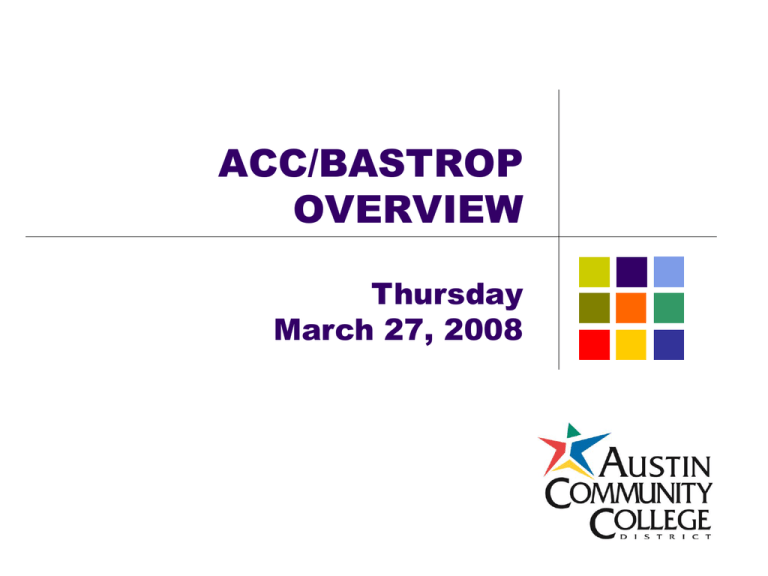ACC/BASTROP OVERVIEW Thursday March 27, 2008
advertisement

ACC/BASTROP OVERVIEW Thursday March 27, 2008 ACC/Bastrop Overview Agenda ACC District Service Area Community Colleges Different from 4-Year Institutions ACC Campuses Bastrop County Statistics Bastrop County Student Enrollment Why Do Communities Join ACC’s Tax Base? Tax Comparison Tuition Comparison Curriculum Comparison Student Services Comparison Enrollments Tax Impact – Property Owners Future Plans Analysis of Future Bastrop Campus Contact Information ACC District Service Area Regional Community College Black = In-district Green = Out-of-District Community Colleges Different from 4-Year Institutions The State funds community colleges differently than 4year colleges and universities. Community Colleges, by law, are designated a Service Area and, by law, must have In-District and Out-ofDistrict tuition rates. In-District rates are lower, in recognition of local tax paid in support of the community Out-of-District rates are higher Community Colleges Different from 4-Year Institutions The State mandate for community colleges is broader and more diverse than 4-year institutions. The State expects community colleges to have local tax support to fund facilities and operations. There are different levels of programming and support services for In-District and Out-of-District. Community Colleges Different from 4-Year Institutions Texas’ Closing the Gaps initiative necessitates that growing communities assess their level of education access, and affordability, on a periodic basis. To gain a comprehensive community college requires a tax. Local, In-District tax payers won’t subsidize Out-of-District costs. Out-of-District rates are higher. ACC Campuses ACC does not build campuses outside its taxing authority. New Campuses There are different levels of instructional programming and support services for In-District and Out-of-District students. Local, In-District taxpayers will not subsidize Out-of-District costs. Round Rock San Marcos Land banking Leander area Manor area Bastrop County Dripping Springs/Wimberley Bastrop County Statistics • Bastrop County population estimate as of January 1, 2007 was 72,859 • Median Income for households $43,578 • Per capita income $18,146 • 18.7% increase in African-American population* • 60.9% increase in Hispanic population* • 46.1% increase in economically disadvantaged, 20002005 *2010 Projections, Texas State Data Center Bastrop County Statistics • Bastrop County-Wide Education Levels • ISDs (County) drop rate 7.9% • Transition to higher education institutions 4 year: 2002/03 137 (19%) 2003/04 176 2004/05 2005/06 2 year: 2002/03 63 (8.7%) (24.8%) 2003/04 74 (10.4%) 188 (24.7%) 2004/05 86 (10.8%) 181 (24.0%) 2005/06 52 (6.9%) 2002/03 59 (8.2%) 2003/04 53 (7.5%) 2004/05 86 (11.3%) 2005/06 78 (10.3%) To ACC: • • High School Graduate or higher • 1990, 68.3% 2000, 76.9% Bachelor’s degree or higher • 1990, 13.3% 2000, 17.0% Bastrop County Student Enrollments Fall 2003 Fall 2004 Fall 2005 Fall 2006 Fall 2007 % Change Fall 2003-2007 Bastrop 161 153 170 179 225 39.75% Other Bastrop County 296 314 332 384 413 39.53% Cedar Creek 62 81 80 93 110 77.42% Elgin 154 136 146 168 183 18.83% McDade 11 9 9 14 8 -27.27% Paige 14 15 14 25 17 21.43% Red Rock 10 14 31 27 23 130.00% Rosanky 6 6 6 7 7 16.67% Smithville 39 53 46 50 65 66.67% Total Bastrop County 457 467 502 563 638 39.61% Early College Start* 23 36 68 70 68 68 55 46 Bastrop County BISD/College Connection *Figure included in Total Bastrop County line Why Do Communities Join ACC’s Tax Base? Expand access to higher ed via lower In-District tuition Texas’ Closing the Gaps initiative Expand programs (i.e., workforce) and support services locally Expand access to higher ed for economic development Must reverse trend of too few high school grads (and too few adults) entering higher education Expand local tax base by creating better educated/better paid local workforce Respond to county needs Return on investment Every dollar spent in the state’s higher ed system returns more than $5.50 to the Texas economy. (Texas Comptroller’s Report February 2005) Tax Comparison Out-of-District In-District • Very limited programs and services • Expanded access & affordability; more programs and services • No tax to ACC • 9 cents M & O tax • City of Bastrop Tax Rate: $0.5350 • Bastrop County Tax Rate: 0.4932 • Bastrop ISD Tax Rate: $1.5010 • ACC Tax Rate $.0958 M&O & Bonds Tuition Comparison Out-of-District (Bastrop) In-District ● ● $118 per credit hour $39 per credit hour Typical 3 Credit Hour Course Full-Year, FullTime Out-of-District Cost $399 per course $3,192 per year In-District Cost $162 per course $1,296 per year Student Savings $237 per course $1,896 per year Curriculum Comparison Out-of-District: In-District: ● Limited General Education transfer courses (7 subject areas) at Bastrop Center ● Expanded General Education transfer courses ● No Workforce Education Courses ● Workforce Education Courses ● No “access/foundation skills” programs for those not “college ready” ● ● No Continuing Education “Access/Foundation” Skills Programs: ● Developmental Education for those not college ready ● Adult Basic Education, GED, English as a Second Language ● Most residents drive to Austin campuses for broader array of programs and services, and pay higher tuition. ● Continuing Education ● Customized Training for business/ industry Student Services Comparison Out-of-District: In-District: No On-Site Student Services No College Library No Learning Lab Limited Testing Center hours On-Site Student Services Financial Aid Office Admissions & Record Office Assessment Testing Advising/Counseling Career Counseling College Library Learning Lab Free tutoring to students Testing Center Larger Designated Space Computerized Enrollments Out-of-District (Bastrop): In-District: Early College Start Not Free Free Early College Start Credit Classes Free College Connection Program Free College Connection Program Articulated Tech-Prep Workforce Education Programs to Match Curriculum Expansion Tax Impact – Property Owners Property Value $40,000 $80,000 $120,000 $160,000 Regular Homestead* $33.53 Annual ($2.79/month) $71.85 Annual ($5.99/month) $110.17 Annual ($9.18/month) $148.49 Annual ($12.37/month) Senior/Disabled* No ACC Tax No ACC Tax $28.74 Annual ($2.40/month) $67.06 Annual ($5.59/month) Commercial $38.32 Annual ($3.19/month) $76.64 Annual ($6.39/month) $114.96 Annual ($9.58/month) $153.28 Annual ($12.77/month) *$5,000 Homestead Exemption *$75,000 Seniors and Disabled Exemptions Future Plans ACC Master Plan is tied to Closing the Gaps Calls for future expansion of the ACC District Calls for future campuses, subject to successful annexations, in: San Marcos Williamson County/Round Rock Bastrop County Annexation must be locally-driven effort, though College will help guide the process. Analysis of Future Bastrop Campus Campus Assumptions & Construction Costs Current FY2013 FY2020 FY2025 638 12,760 242,440 835 16,700 317,300 1,102 22,040 418,760 1,293 25,860 491,340 1,714 34,280 2,086 41,720 2,367 47,340 651,320 792,680 899,460 $ 2,900,000 $ 937,500 $ 2,900,000 $ 1,125,000 Enrollment Without Annexation and Campus Fall Headcount Annual Semester Credit Hours Annual Contact Hours With Annexation and Campus Fall Headcount Annual Semester Credit Hours Annual Contact Hours Construction Costs Land Acquisition (100 Acres) Buildings General Purpose (50,000 sqft.) Workforce (25,000 sqft.) Debt Service for Campus Cost Plant Maintenance & Operation Costs *See attached document, “Analysis of Future Bastrop Campus” $ 5,000,000 $17,500,000 $ 8,750,000 $31,250,000 $ 2,300,000 $ 750,000 Analysis of Future Bastrop Campus Campus Operating Budget FY2013 FY2020 FY2025 Revenues $ 8,534,302 $11,672,004 $14,583,104 Expenses $ 8,532,260 $11,662,175 $14,048,194 Net Revenues less Expenses $ $ $ Number of Full-Time Employees Potential Economic Impact *See attached document, “Analysis of Future Bastrop Campus” 2,042 9,829 534,911 60 72 86 $42,661,300 $58,310,875 $70,240,968 Want More Information? Web: http://austincc.edu ACC Master Plan: http://www.austincc.edu/masterplan/ Texas’ Closing the Gaps Initiative: http://www.thecb.state.tx.us/ClosingtheGaps/ The Impact of the State Higher Education System on the Texas Economy: http://www.window.state.tx.us/specialrpt/highered05/ The Socioeconomic Benefits Generated by 50 Community College Districts in Texas: http://www.tacc.org/e_impact.htm What’s the Return on Education?: http://www.nytimes.com/2005/12/11/business/yourmoney/11view.html For More Information Stephen Kinslow, Ph.D. President/CEO ceo@austincc.edu 512-223-7598 Mary Hensley, Ed.D. Vice President, College Support Systems and ISD Relations mhensley@austincc.edu 512-223-7618 For copies PowerPoint Presentation: www.austincc.edu/isd/bastrop_isd/032708Presentation.ppt



